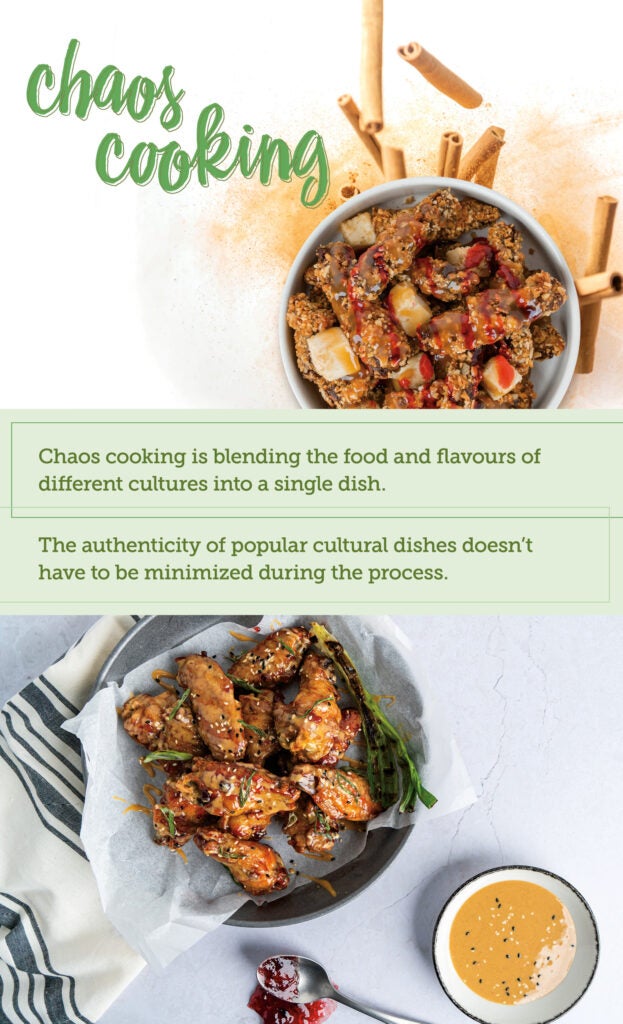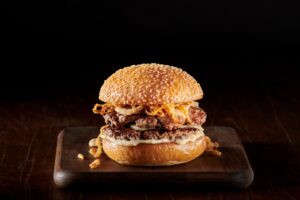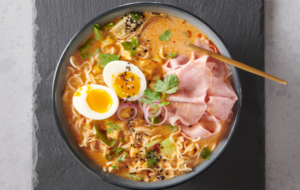It turns out Wolfgang Puck was onto something in the ‘70s when he introduced uncommon flavour pairings to the masses – a trend known then as ‘fusion cuisine.’
Fast-forward decades later, a slightly more aggressive trend known as ‘chaos cooking’ is taking fusion cuisine “to a whole other level,” said Kurt Kwiatkowski, Gordon Food Service® Corporate Executive Chef.
Chaos cooking is blending the food and flavours of different cultures into a single dish. And like so many culinary trends, it was fueled by the pandemic and social media, namely Tik Tok.
“It’s something that tells a story,” Kwiakowski said.
Kwiakowski considers Puck a “pioneer of chaos cooking” who knew how to take global flavours and turn them into mashup masterpieces. Puck is known for creating dishes like Buffalo Chicken Spring Roll or pizza topped with salmon and caviar, he said.
Paul-André Miron Piché, Gordon Food Service® Culinary Specialist in Quebéc, is excited to see where chefs today will take the trend. “It’s about breaking the mold, breaking boundaries,” he said.
Orderly Chaos
Don’t let the name fool you: Chaos cooking isn’t a result of flavours haphazardly thrown together. It’s quite the opposite, Kwiakowski said. “We’re not doing whatever we want. It’s intentionally done,” he said. The result of mashing together “world flavours” results in endless possibilities, he said.
He references mashups that include spices and cooking techniques from Italy, Chicago, India, and Japan, like the pastrami taco found in New York, or the lox and cream cheese pizza with fried capers originally crafted by Puck at his restaurant, Spago in Los Angeles.
It’s important to note, Kwiatowski said, the authenticity of popular cultural dishes doesn’t have to be minimized during the process.
“You can keep the authentic flavours. You might just be delivering it in a different way.” Miron Piché agrees: “Every different culture has a staple dish or a main ingredient they use in their dishes. You just have to try different things.”
It’s also how the food is prepared.
“Cooking techniques are still important too. This isn’t just throwing a dish together or sprinkling some soy sauce on a pasta dish and calling it chaos cooking,” Kwiatowski said. “In the end, flavours matter. That’s what’s going to rule supreme.”
A Dash of Creativity, A Pinch of Purpose
It takes two things to create a true chaos-cooking dish: An imagination and even more importantly– purpose. And it takes a lot of skill to get it right, Kwiatowski said. “Putting a dish on your menu or redesigning your menu to have a lot of dishes that are a result of chaos cooking has been successful when they are done with a specific reason,” he said.
Sheal Patel, the chef behind the Chicago pop-up Dhuaan BBQ, is a great example. According to an article on the website, Eater, he is one of many chefs driven by the urge to push back against the exception of cooking only the food of their cultural backgrounds. Patel started cooking because he thought Indian flavours paired well with red meats that are more common in America.
“People want to tell a story, and as a customer, a lot of people want to hear and taste what that story is,” Kwiatowski said.
And that’s a great place to start for any chef or operator looking to add chaos-cooking dishes to their menu, he said. Take some time to think about what message you want to send or what story you want to tell with your food.
See more issues of Foodscape here.


























